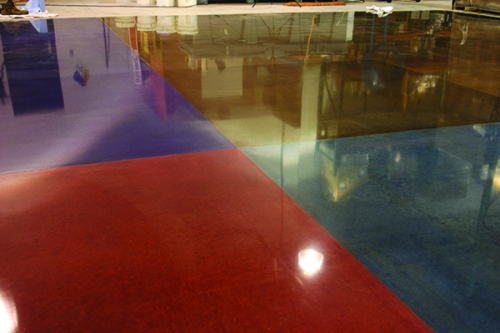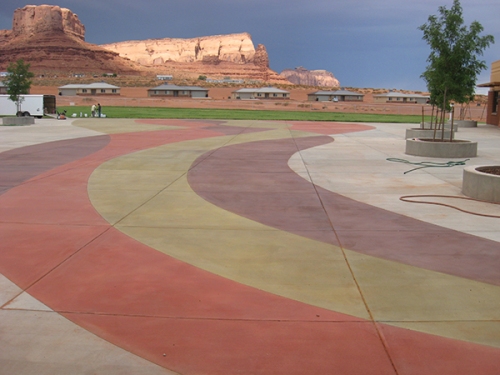
This 45,000 s/f Harley Davidson of Erie dealership went from abandoned grocery store to gleaming motorcycle emporium in just 80 days, including the polished concrete floors. photos courtesy Cori Sutton, Diamond Designer Concrete
“We’re used to horrible old floors,” said Cori Sutton, Diamond Designer Concrete, Erie, Pa. “It wasn’t a big deal. We knew what to expect.”
The newly exposed concrete floor at the Harley-Davidson of Erie dealership met the expectations for “horrible” of Cori, her older brother and partner Matt Maya, and their crew when they arrived on the job site in May.
The 45,000 square-foot facility had been a grocery store, abandoned for five years to birds and dust. It fell to Cori and a host of other trades to fast-track the forgotten facility into its second life as a high-powered Harley dealership. They had to do it by July and the looming, legendary “Roar on the Shore” biker rally for charity. The annual rally brings up to 80,000 bikers into town for three days of rides, parades, bands and other special events.
As a major sponsor of “Roar,” dealership owners Kelly and Susan Lapping were set to be at ground-zero. More than anything, they wanted a beautiful, spacious and completed setting in which to play host and display their Harleys to the incoming crowds.
First, Cori, Matt and crew had to whip 17,245 square feet of old concrete into shape.
The GC, award-winning Odyssey Builders, Erie, took the VCT tiles off, presenting the Diamond Designer Concrete team with a floor that hadn’t seen daylight since it was poured.
“It was in really bad shape,” Cori recalled.
Trench repairs for plumbing, both old and new, spanned the floor. Pitted, cracked, chipped, and spalled concrete stretched from wall to wall, still covered in patches of rock-hard, ages-old adhesive from the torn-up tiles.
“The adhesive made the floor horribly rough,” Cori said. “We had to grind it off.” In addition, the floor was uneven and wave-like. “We didn’t measure the difference between the high spots and low spots,” Cori said, “but it was significant.”
Diamond Designer Concrete brought two grinders, each weighing nearly half-a-ton, to flatten and smooth the craggy, uneven surface. Removing the glue was rough and bumpy said Cori, who did her time running the thousand-pounders along with her brother and their crew. But that was just the start.
The Diamond Designer Concrete team worked against deadline to repair countless cracks, spalls and other defects in the floor with products and procedures from Metzger/McGuire, Concord, N.H.
Metzger/McGuire is a manufacturer of joint fillers and repair materials for retail and industrial concrete flooring.
Metzger/McGuire field rep Matt Rizzo, who visited the site, said their work impressed him.
“That floor looked like a jigsaw puzzle, it had so much random cracking,” Rizzo said. “They could’ve done less, but they went the extra step.”

A “grid pattern” from years of VCT tile covering heightens the floor’s “industrial” look. Repairs to countless, cracks, spalls and boltholes are harder to spot.
Despite the looming deadline, Cori, Matt and company took pains to make sure the joints were perfectly sanded and defects filled with the right repair materials the right way, Matt said. “I can tell just from looking at the photos,” he added.
“One of the biggest problems was that there were many parts to the old floor,” Cori said. “It wasn’t just one pour. Every section had a different strength of concrete; sometimes hard, sometimes soft.”
That meant an additional drain on the team’s already scarce time as they changed diamonds to match varied floor conditions. Repeated grinds at ever finer grits of metal bond diamonds gradually smoothed and flattened the floor, making the job faster and easier. After their final grind and before beginning polishing, Cori’s team colored the floor with Consolideck GemTone Stains “Espresso.”
This part of the job went quickly, Cori said. They applied the water-based color with pump-up sprayers and micro-fiber applicators, smoothing it out into a rich brown translucent tint. As soon as the floor dried, about 20 – 60 minutes, the crew followed the same procedure to harden and densify the floor with Consolideck LS lithium-silicate hardener/densifier.
Hardening/densifying offers several benefits for polished concrete floors, and their installers and owners.
LS converts soft calcium hydroxide into rock-hard calcium silicate hydrate — the same substance that makes concrete hard to begin with. Without hardening/densifying, unreacted calcium hydroxide quickly turns into concrete “dust,” the bane of concrete floors.
Hardening/densifying eliminates dusting.
The reaction fills microscopic pores in the concrete with calcium silicate hydrate. It creates a harder, denser, more monolithic surface that polishes faster, easier and with better results.
After a sub-60-minute dry time, The Diamond Designer Concrete team began polishing. They took the finish in stages to a mirror-like 1,500 grit finish. Propane burnishing melded an ultra-thin coat of Consolideck LSGuard into the floor, locking in the water-based color and increasing the floor’s already considerable gloss and stain- and abrasion-resistance.
“It wasn’t in the best of shape,” says co-owner Kelly Lapping with a chuckle, recalling the floor before Diamond Designer Concrete got to it. “Cori and her group did a fantastic job, and they got it done with two weeks to spare before ‘Roar’.
“We absolutely love it,” he said.
# # #

Bikes reflect in the polished concrete floor created by Diamond Designer Concrete, with products from PROSOCO and Metzger/McGuire.
Read Full Post »
 h of certifications and registrations that are relevant for the industry’s sustainable, resilient products crowd.
h of certifications and registrations that are relevant for the industry’s sustainable, resilient products crowd.




















